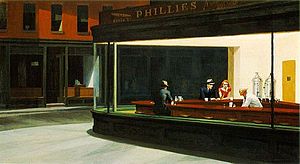
I always enjoy artist works, paintings, drawing, etc., that tell stories, or leaves enough unsaid that creates an imagined and entertaining moment in the viewers mind. An example of this would be the picture to the right.
Fair use rationale for Nighthawks:
The artwork is being used in an article about the artwork itself.
The JPEG is of lower resolution than the original and copies made from it are of inferior quality
Imagine this, in the painting, the man with the hawk face rests his right hand on the counter holding a cigarette; his fingers nearly touching the woman’s hand. Without paying attention, she seems to be deep in thought (perhaps, thinking about some previous conversation the two had that did not turn out well). Nonchalantly, she stares at her fingernails seemingly inspecting them. You, the viewer, know there is more to this story. What happens next is only in your imagination. What drama! What a painting!
For several years now, I’ve kept Edward Hopper’s painting, Nighthawks, as a screen savor on my computer. I spent much of my forty years of “business world” life traveling around the world, having been in most all major cities in the United States and many in Europe. Often, I would go late night to a lonely diner. The scene Hopper depicted in the painting was very real. I was able to associate with it. I often consider myself to have been the witness to the scene sitting with his back to the viewer of the painting. Edward Hopper told stories in his painting that each viewer makes up in his mind. Hopper created emotion in his paintings. Isn’t that what all of us artists are supposed to do? Hopper, however, was a genius at it. He did his job, and he did it well. If you study the painting, you will note the unusual use of perspective, color, and light.
